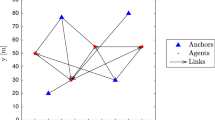Abstract
In conventional localization, agents may not be able to reach sufficient number of anchors to obtain unambiguous locations, especially in sparse networks. Cooperative localization is a promising solution in that harsh environment, which enables the agents to cooperate with each other by exchanging location information and performing range measurements. In this paper, a distributed cooperative localization method based on factor graph is proposed in wireless networks. Gaussian parametric messages are used to represent the messages passed on factor graph. However, because of the nonlinear observation model, no closed-form solutions can be obtained. To solve this problem, the Taylor expansion is used to approximate the nonlinear terms in message updating, which leads to the Gaussian message passing on factor graph. Accordingly, only two parameters of the Gaussian distribution have to be transmitted and the communication overhead for localization can be significantly reduced. The two proposed algorithms for the application with accurate and inaccurate anchors, respectively, are evaluated by Monte Carlo simulations and compared with the SPAWN and maximum likelihood (ML) estimator. The results show that the proposed algorithms can perform very close to SPAWN with much lower computational complexity, and it outperforms the ML estimator significantly.
Similar content being viewed by others
References
Gustafsson F, Gunnarsson F. Mobile positioning using wireless networks: possibilities and fundamental limitations based on available wireless network measurements. IEEE Signal Process Mag, 2005, 22: 41–53
Gezici S, Tian Z, Giannakis G B, et al. Localization via ultra-wideband radios: a look at positioning aspects for future sensor networks. IEEE Signal Process Mag, 2005, 22: 70–84
Sayed A H, Tarighat A, Khajehnouri N. Network-based wireless location: challenges faced in developing techniques for accurate wireless location information. IEEE Signal Process Mag, 2005, 22: 24–40
Li B, Wu N, Wang H, et al. Expectation-maximisation-based localisation using anchors with uncertainties in wireless sensor networks. IET Commun, 2014, 8: 1977–1987
Hofmann-Wellenhof B, Lichtenegger H. Global Positioning System: Theory and Practice. 5th ed. Berlin: Springer, 2001
Win M Z, Conti A, Mazuelas S, et al. Network localization and navigation via cooperation. IEEE Commun Mag, 2011, 49: 56–62
Patwari N, Ash J N, Kyperountas S, et al. Locating the nodes: cooperative localization in wireless sensor networks. IEEE Signal Process Mag, 2005, 22: 54–69
Dardari D, Conti A, Lien J, et al. The effect of cooperation on localization systems using UWB experimental data. EURASIP J Adv Signal Process, 2008, 2008: 1–11
Caceres M A, Sottile F, Garello R, et al. Hybrid GNSS-ToA localization and tracking via cooperative unscented Kalman filter. In: Proceedings of the Personal, Indoor and Mobile Radio Communications (PIMRC), Instanbul, 2010. 272–276
Sottile F, Wymeersch H, Caceres M A, et al. Hybrid GNSS-terrestrial cooperative positioning based on particle filter. In: Proceedings of IEEE Global Telecommunications Conference (GLOBECOM), Houston, 2011. 1–5
Wang L, Wan J W, Liu Y H, et al. Cooperative localization method for multi-robot based on PF-EKF. Sci China Ser-F: Inf Sci, 2008, 51: 1125–1137
Ihler A T, Fisher J W, Moses R L, et al. Nonparametric belief propagation for self-localization of sensor networks. IEEE J Sel Areas Commun, 2005, 23: 809–819
Wymeersch H, Lien J, Win M Z. Cooperative localization in wireless networks. Proc IEEE, 2009, 97: 427–450
Wymeersch H, Ferner U, Win M Z. Cooperative Bayesian self-tracking for wireless networks. IEEE Commun Lett, 2008, 12: 505–507
Caceres M A, Penna F, Wymeersch H, et al. Hybrid cooperative positioning based on distributed belief propagation. IEEE J Sel Areas Commun, 2011, 29: 1948–1958
Lien J, Ferner U J, Srichavengsup W, et al. A comparison of parametric and sample-based message representation in cooperative localization. Int J Navig Obs, 2012, 2012: 281592
Zhang X, Cui Q, Shi Y, et al. FG-based cooperative group localization for next-generation communication networks. In: Proceedings of IEEE Vehicular Technology Conference (VTC Fall), Quebec City, 2012. 1–5
Kschischang F R, Frey B J, Loeliger H A. Factor graphs and the sum-product algorithm. IEEE Trans Inf Theory, 2001, 47: 498–519
Kullback S, Leibler R A. On information and sufficiency. The Annals of Mathematical Statistics, 1951. 79–86
Zhu H, Wang J. Chunk-based resource allocation in OFDMA systems-Part I: chunk allocation. IEEE Trans Commun, 2009, 57: 2734–2744
Zhu H, Wang J. Chunk-based resource allocation in OFDMA systems-Part II: joint chunk, power and bit allocation. IEEE Trans Commun, 2012, 60: 499–509
Author information
Authors and Affiliations
Corresponding author
Rights and permissions
About this article
Cite this article
Wu, N., Li, B., Wang, H. et al. Distributed cooperative localization based on Gaussian message passing on factor graph in wireless networks. Sci. China Inf. Sci. 58, 1–15 (2015). https://doi.org/10.1007/s11432-014-5172-y
Received:
Accepted:
Published:
Issue Date:
DOI: https://doi.org/10.1007/s11432-014-5172-y




